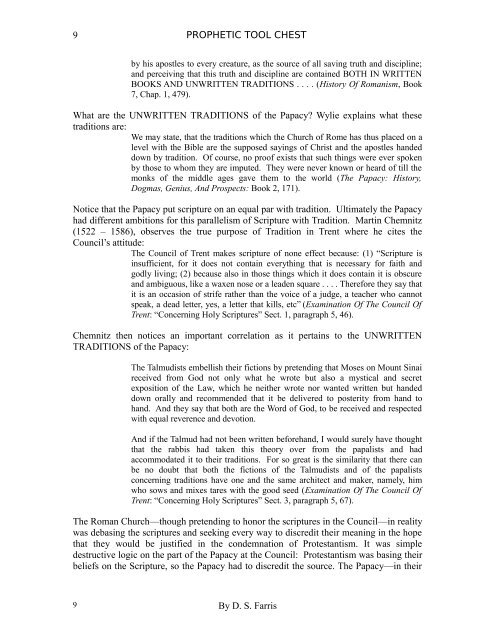CHAPTER SEVEN - Prophetic Toolchest
CHAPTER SEVEN - Prophetic Toolchest
CHAPTER SEVEN - Prophetic Toolchest
Create successful ePaper yourself
Turn your PDF publications into a flip-book with our unique Google optimized e-Paper software.
9<br />
PROPHETIC TOOL CHEST<br />
by his apostles to every creature, as the source of all saving truth and discipline;<br />
and perceiving that this truth and discipline are contained BOTH IN WRITTEN<br />
BOOKS AND UNWRITTEN TRADITIONS . . . . (History Of Romanism, Book<br />
7, Chap. 1, 479).<br />
What are the UNWRITTEN TRADITIONS of the Papacy? Wylie explains what these<br />
traditions are:<br />
We may state, that the traditions which the Church of Rome has thus placed on a<br />
level with the Bible are the supposed sayings of Christ and the apostles handed<br />
down by tradition. Of course, no proof exists that such things were ever spoken<br />
by those to whom they are imputed. They were never known or heard of till the<br />
monks of the middle ages gave them to the world (The Papacy: History,<br />
Dogmas, Genius, And Prospects: Book 2, 171).<br />
Notice that the Papacy put scripture on an equal par with tradition. Ultimately the Papacy<br />
had different ambitions for this parallelism of Scripture with Tradition. Martin Chemnitz<br />
(1522 – 1586), observes the true purpose of Tradition in Trent where he cites the<br />
Council’s attitude:<br />
The Council of Trent makes scripture of none effect because: (1) “Scripture is<br />
insufficient, for it does not contain everything that is necessary for faith and<br />
godly living; (2) because also in those things which it does contain it is obscure<br />
and ambiguous, like a waxen nose or a leaden square . . . . Therefore they say that<br />
it is an occasion of strife rather than the voice of a judge, a teacher who cannot<br />
speak, a dead letter, yes, a letter that kills, etc” (Examination Of The Council Of<br />
Trent: “Concerning Holy Scriptures” Sect. 1, paragraph 5, 46).<br />
Chemnitz then notices an important correlation as it pertains to the UNWRITTEN<br />
TRADITIONS of the Papacy:<br />
The Talmudists embellish their fictions by pretending that Moses on Mount Sinai<br />
received from God not only what he wrote but also a mystical and secret<br />
exposition of the Law, which he neither wrote nor wanted written but handed<br />
down orally and recommended that it be delivered to posterity from hand to<br />
hand. And they say that both are the Word of God, to be received and respected<br />
with equal reverence and devotion.<br />
And if the Talmud had not been written beforehand, I would surely have thought<br />
that the rabbis had taken this theory over from the papalists and had<br />
accommodated it to their traditions. For so great is the similarity that there can<br />
be no doubt that both the fictions of the Talmudists and of the papalists<br />
concerning traditions have one and the same architect and maker, namely, him<br />
who sows and mixes tares with the good seed (Examination Of The Council Of<br />
Trent: “Concerning Holy Scriptures” Sect. 3, paragraph 5, 67).<br />
The Roman Church—though pretending to honor the scriptures in the Council—in reality<br />
was debasing the scriptures and seeking every way to discredit their meaning in the hope<br />
that they would be justified in the condemnation of Protestantism. It was simple<br />
destructive logic on the part of the Papacy at the Council: Protestantism was basing their<br />
beliefs on the Scripture, so the Papacy had to discredit the source. The Papacy—in their<br />
9<br />
By D. S. Farris


